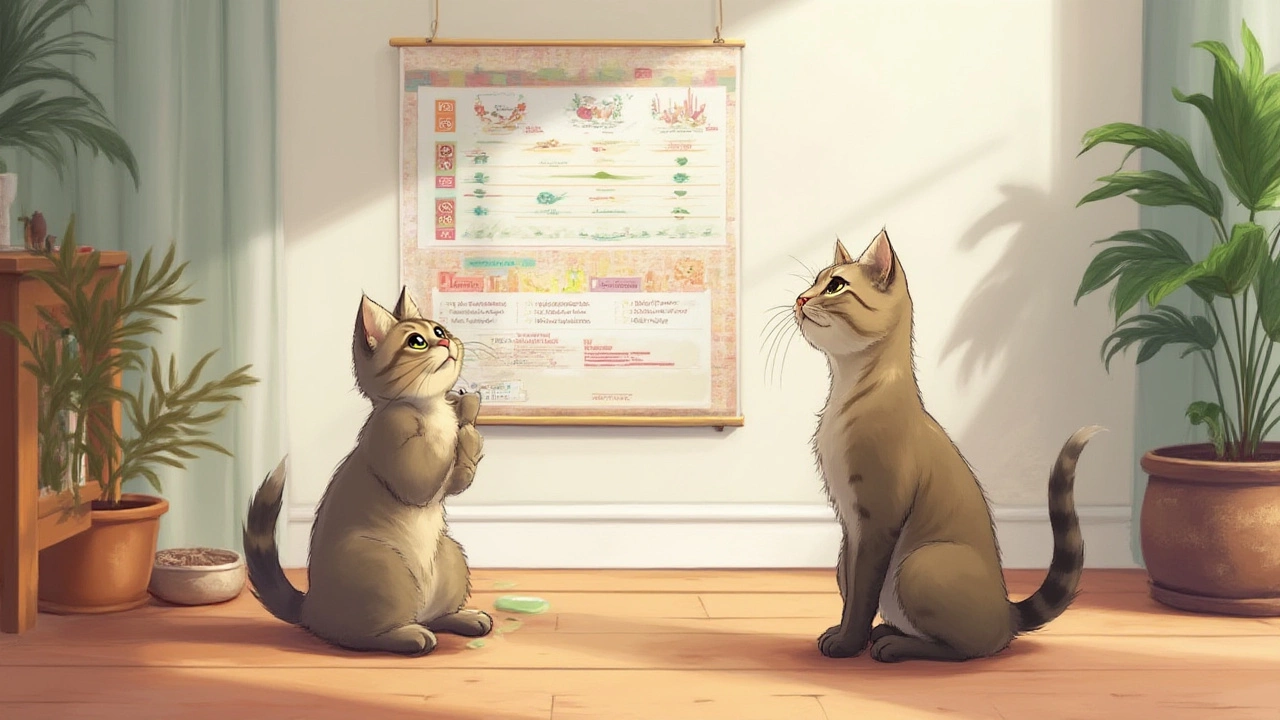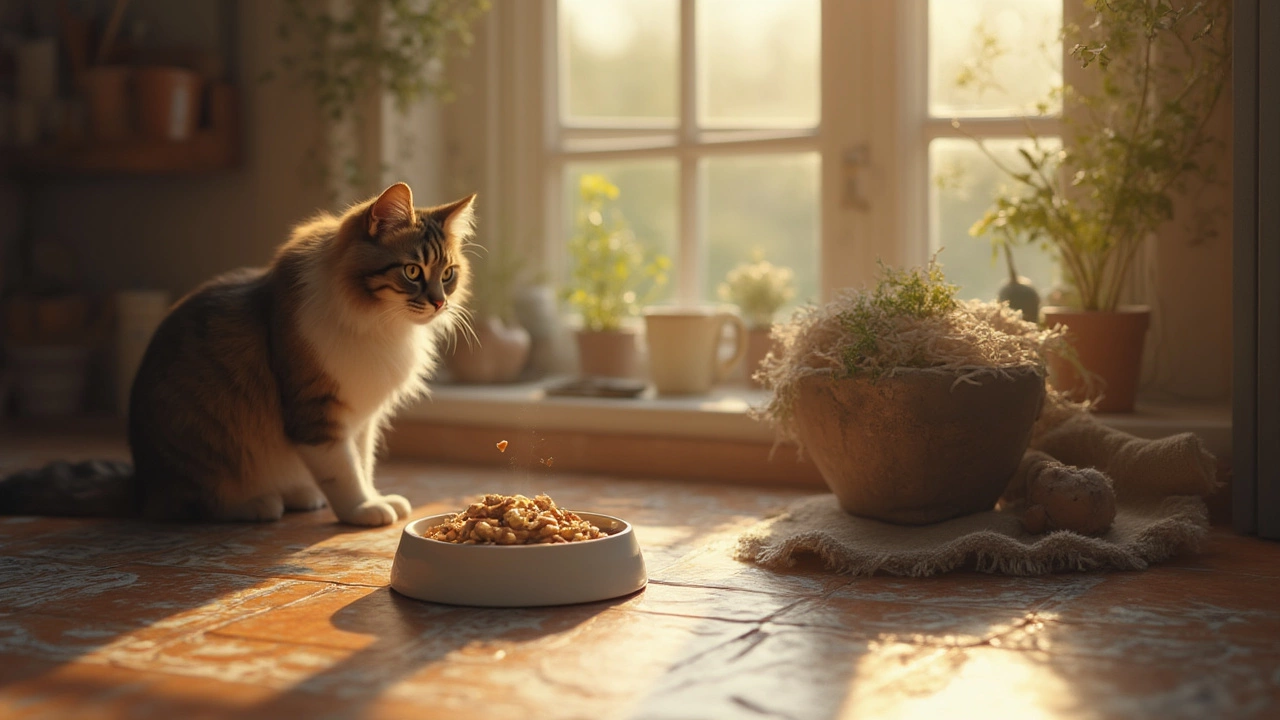Ever caught your cat stalking a sunbeam at 3 p.m. and wondered if she’s actually hungry again, or just living her best drama queen life? It’s a daily riddle for most cat parents: how many times should you actually feed your cat? If you ask Luna—my fiercely independent calico—she’ll tell you the answer is "every time I blink." But science and experience say otherwise.
What Experts Say About Cat Meal Frequency
Cats are surprisingly finicky eaters, but their bodies crave routine far more than novelty. Veterinarians and feline nutritionists pretty much agree: most healthy adult cats do best with two meals a day. That’s breakfast and dinner—about 8 to 12 hours apart. This rhythm matches their natural instinct as hunters. Biologically, cats would snag small prey every few hours, and those short breaks between meals work for their digestive systems today, too.
Kittens flip the script, though. Because they grow like weeds, kittens need more frequent meals—ideally, three to four times a day, evenly spaced out, especially up to six months old. This helps their tiny tummies cope and fuels rapid growth. Once they hit the adult mark (around one year), they can usually switch to two squares a day without complaint.
But there’s leeway here. Some healthy adult cats on dry food do okay with free-feeding—leaving kibble out all day—if they’re not overeaters. Others benefit from three smaller, scheduled meals, especially if they get hangry (you know, the classic early morning yowls or batting your feet at dawn). Portion control helps prevent obesity, and that's not just a buzzword; according to the Association for Pet Obesity Prevention’s 2024 survey, around 61% of cats in the U.S. are classified as overweight or obese. Chonky might be cute on TikTok, but those pounds can mean diabetes, joint problems, and a shorter life.
Always tune the schedule to your specific cat. If Luna got free access to kibble, she'd double in size in a month—she’s a sucker for snacks! Your cat might self-regulate, but Rex (the dog) would happily hoover up any extras. That’s why keeping set meal times just makes life easier for everyone.
| Cat Age | Recommended Number of Meals | Notes |
|---|---|---|
| 2-6 months (kitten) | 3-4 | More frequent feeding for growth |
| 6-12 months (young cat) | 2-3 | Transitioning to adult schedule |
| 1+ years (adult) | 2 | Breakfast and dinner |
| Senior cats | 2 or more | Watch teeth & digestion |

Factors That Affect Your Cat’s Feeding Schedule
The magic number of meals isn’t set in stone for every cat. There are a bunch of factors that can nudge you off the "twice-a-day" path. Start with your cat’s age, but juggle in her weight, activity level, breed, lifestyle, and any health quirks too.
Some cats burn calories like Olympic athletes. Playful breeds like Bengals or young house tigers might zap through energy quicker, so they could use an extra meal or two (or just a little more in their bowl). Compare that to a content, snoozy tabby who prefers meditating on your windowsill—she probably won’t need more than two meals unless your vet says otherwise.
Sickness changes things, too. Cats with diabetes or thyroid issues often need more regulated feeding. If you’re using timed injections of insulin, for example, you want to sync meals to that schedule. Seniors can also be finicky. They may lose teeth or get digestive issues, making small, frequent meals easier to handle. And don’t forget about those cats that just... love their food. Maybe your buddy is on a new diet, dropping weight, or gaining too much. Adjust meal sizes and times as needed, but ask a vet for advice.
Let’s talk about wet food vs. dry food. Wet food tends to get gobbled up quickly and spoils faster, so it works best for scheduled feeding. Dry food can sit out longer, but if your cat can’t resist a crunchy snack binge, pre-measured meals are safer for their waistline. According to a 2023 study from the American Veterinary Medical Association, cats on wet food tend to feel fuller with fewer calories than those who graze on dry food. Translation: if you’re wrestling with your cat’s weight, rationed wet food at set mealtimes could work wonders.
You also want to keep an eye on clues from your cat. Sudden changes in appetite—like scarfing everything down, or ignoring food for two days straight—or changes in weight are worth a call to your vet. Healthy adult cats sometimes "hunt" their food around the clock if you scatter kibbles for enrichment. But a complete lack of interest? That’s a red flag, not just feline fussy-ness.
Lastly, your own life shapes your cat’s meal plan. Working long hours and worried about dinnertime? Automatic feeders or enlisting friends can maintain a schedule that won’t leave your furball hangry or your carpet a mess. Cats are creatures of habit, and sticking to a predictable routine tells them they can rely on you—even if all they show for it is a quick headbutt or tail flick.

Tips for Building the Right Cat Feeding Routine
The trick is balancing your cat’s health, instincts, and your schedule. Your cat benefits from a cat feeding schedule that doesn’t just dump the right food in the bowl, but keeps her engaged and happy. Here’s how you can hit that solid middle ground:
- Stick to the clock. Cats learn quickly when mealtime rolls around. Set your alarm (if your cat hasn’t already!), and keep meals consistent.
- Portion control, every time. Check the feeding guidelines on your cat food, but measure with a real scoop. It’s easy to "eyeball" the wrong amount. Smalls amounts spread across meals help keep metabolism healthy.
- Enrich mealtime. Scatter kibble in a puzzle feeder or split up her meal in "hunting" stations around the house. This triggers her prey drive and keeps boredom at bay.
- Observe and adapt. If your cat’s bowl still has food hours later, or she’s scarfing it all in a minute, adjust portion sizes up or down gradually. Notice if she seems sluggish or suddenly more active.
- Hydration matters, too. If your cat eats mostly dry food, tempt her with several bowls of fresh water around the house. Some cats love water fountains. Wet food counts toward hydration but isn’t the only answer.
- All cats are different. Don’t panic if your friend’s Ragdoll eats four times a day and yours sticks to two. If she’s healthy and her weight is steady, she’s probably getting what she needs.
- Talk to your vet before big changes. Whether you're switching food type, adding meals, or notice a big appetite shift, run it past your vet before going full DIY.
- Don’t fall for the guilt trip. Trust me, cats are Oscar-worthy actors when there’s food involved. If yours is a "beggar," give low-cal treats or set aside mealtime hustle for dedicated play.
A solid routine helps cats feel secure and reduces stress—especially in multiple-cat households. Luna and Rex? They’re a team at meal-begging time, but separate bowls, spaced apart, cut down on rivalry. Sometimes, feeding cats in different rooms can prevent food bullying, too. If you're up for some experimentation, try feeding at slightly different times on weekends (by 30 minutes) to prevent your cat training you to wake up before sunrise.
Feeling overwhelmed by all these rules? Don’t worry—cats are both forgiving and persistent. If you’re patient, pay attention, and keep that vet in your contacts, you’ll figure out the "pawfect" schedule for your furry favorite.
So next time Luna stretches out, gives me her patented slow-blink, and circles her food bowl at 5:01 p.m. on the dot, I know she’s not just hungry—she’s thriving on routine, and you can help your cat do the same.
